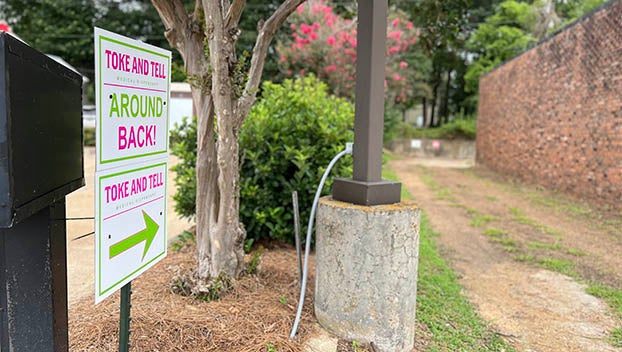Self defense argued in murder trial
Published 12:28 am Friday, September 23, 2016
NATCHEZ — The murder trial of a Natchez man accused in a 2015 shooting death began Thursday with the defense arguing the shooting was in self-defense.
Casey S. Woods, 43, 125 Gaylor Road, is accused of killing 42-year-old Pierre Tenner on May 24, 2015.
Woods turned himself into authorities a few days after the shooting.
The shooting reportedly took place around 12:30 p.m. in the driveway of 14 Hampton Court, the residence of Tenner’s estranged wife, Doris. Pierre Tenner, after sustaining a gunshot wound to the upper right hip, was pronounced dead at 1:30 p.m. at Merit Health Natchez.
Assistant District Attorney Tim Cotton began his opening statement describing events that occurred a few weeks prior to the shooting. Cotton told jurors how Pierre Tenner was arrested for a domestic disturbance after allegedly firing a shot in the Hampton Court house. No one was injured, he said.
Part of the condition of his bond was that he was to not have any contact with his wife, Doris Tenner, Cotton said.
On May 24, Cotton said Pierre Tenner went to the house across the street at 7 Hampton Court to talk to Paul Armstead, who testified Thursday. During that conversation, Cotton said Woods ignored Doris Tenner’s plea to not confront Pierre Tenner.
Woods came outside to wash a vehicle and at some point Woods and Pierre Tenner began arguing across the street at each other, Cotton said.
Woods then allegedly went inside the residence, got a shotgun, and came outside and shot Pierre Tenner.
“Yes, Mr. Tenner walked across the street to 14 Hampton Court, after all, it was his home,” Cotton said. “Evidence will show prior to him getting there, Tenner stopped in the road to take his leg brace off, presumably to fight.”
However, Cotton said Woods allegedly brought a gun to a fistfight against a man, Pierre Tenner, who at the time of his death had a blood alcohol level of .242.
“The question you guys have to answer is whether the defendant shooting a 153 pound, heavily intoxicated, unarmed man with a leg brace was in self defense with no reasonable alternative, or whether the defendant acted intentionally with a depraved heart or in the heat of passion, unjustifiably killing Pierre Tenner,” Cotton told jurors.
Defense attorney Zach Jex argued Woods was a man who found himself in a tough situation between an estranged husband and a wife, who had moved on.
Jex said on a Sunday morning Woods was at his girlfriend’s house washing the couple’s vehicles when Pierre Tenner shows up.
Jex said Woods knows what happened three weeks ago when the husband and wife were already estranged. Jex said Pierre Tenner drove by the house, saw Woods’ truck in the driveway and found the door to the house was locked.
Jex said Pierre Tenner forced the door open, and chased Doris Tenner back to the bedroom. As Doris Tenner hid behind the bed, Pierre Tenner fires a blast into the bedroom door.
Pierre Tenner is arrested and later admits to the crime in a statement, Jex said.
On May 24, 2015, Pierre Tenner is again on the street and he and Woods argue, Jex said.
Doris Tenner has called 911 multiple times — 12:15 and 12:25 — but the police haven’t arrived, Jex told jurors.
Pierre Tenner went to his truck and put something behind his back before crossing the street, Jex said. Doris Tenner goes inside to call 911 a third time — 12:30 p.m. — after not being able to convince her husband to leave and being thrown to the ground by her husband, Jex said.
“Pierre Tenner was the aggressor,” Jex said. “Pierre Tenner violated the bond and entered the property.
“Casey Woods knows 911 has been called twice and the police haven’t shown up.
“Casey Woods has to make the impossible decision, to do something a man or a woman should not have to decide to do, which is use a gun to defend himself. He was acting in self defense to protect himself and Doris Tenner.”
The state first called forensic scientist and firearm specialist Lori Beall, who identified the six pellets recovered from Pierre Tenner’s body during the autopsy and also a fired shotgun shell found in the carport trashcan. Beall said the shotgun shell and pellets were consistent with No. 1 buckshot from a Winchester 12-gauge.
Vince Bates was the second witness called by the state. Bates is a patrol officer with the Natchez Police Department and was called to the scene at 12:30 p.m. Bates, working in the area, said he arrived a few minutes later.
Jex asked Bates if he ever received the other two 911 calls. Bates said as far as he knew, the call at 12:30 p.m. was the first call.
While he doesn’t recall exactly what happened that day, Bates said if he’s tied up elsewhere on his beat at the time of a dispatch, they will dispatch a secondary unit.
NPD Investigator Jerry Ford, the third witness, said he first went to the hospital, but Pierre Tenner was already dead when he arrived.
At the police station, Ford interviewed three witnesses, looked over the evidence from the scene and worked to get a bench warrant for the arrest of Woods.
Ford said no weapons were found at the scene of the crime and Woods had fled prior to the arrival of the police.
Jex asked Ford about the statement Pierre Tenner wrote a few weeks earlier at the police department in connection with the aggravated assault charge. Ford said he had never seen the statement.
“As the lead detective, when a man is killed, isn’t it your job to find out all of the surrounding circumstances?” Jex asked.
Ford said, “Yes, I did.”
“But didn’t you just testify to me you didn’t come across these documents?”
Ford said he had spoken to Doris Tenner and she had told him about the incident and he believed he had enough probable cause to arrest Woods.
Ford said to Cotton seeing the aggravated assault documents would not have made a difference in the charges against Woods.
Armstead said he was visiting a neighbor, drinking a beer, when Pierre Tenner drove up. Armstead said it was not unusual for Pierre Tenner to visit with him.
About 15 minutes after Pierre Tenner arrived, Woods came outside to wash his car, and the two began to argue, Armstead said. Armstead said he doesn’t recall who started the argument.
Pierre Tenner did start crossing the street, and Armstead said he doesn’t recall Doris Tenner attempting to stop him or her being thrown down, and Woods went in the house, came back out and shot Pierre Tenner.
Armstead said he did not see Pierre Tenner approach his truck to get anything before crossing the street. Armstead said he doesn’t recall Pierre Tenner having a weapon, and he also said he could not tell whether the man was drunk or not.
When Pierre Tenner was shot, Armstead said he ran across the street to help him.
“I got him in my arms and talked to him,” he said, wiping away tears with a tissue. “I was trying to keep him alive.”
Armstead said Pierre Tenner did not respond and was about to lose consciousness. He helped load him into the back of a truck before police arrived, and took him to the hospital.
Natchez Police crime scene investigator Joseph Belling was the last witness of the day, and he established that the first drop of blood — marker No. 1 — was found approximately 94 inches from a column holding up the carport. From the column to the kitchen door was approximately 17 feet.
Cotton asked Belling to step down from the witness stand to use measuring tape to show the jury how far this distance was.
However, during cross examination, defense attorney Christina Daugherty asked Belling if he could confirm the location of that first drop of blood was where Pierre Tenner was shot.
“No, I cannot say exactly where he was shot,” Belling said. “I would say based on the blood trail, he was shot somewhere near marker No. 1.”
Belling said a larger pool of blood was located near where he was told Pierre Tenner was loaded into the truck. A trail of blood continued down the road, presumably heading to the hospital, Belling said.
Belling also could not confirm the blood on the scene was Pierre Tenner’s beyond circumstantial evidence. Before he could collect a blood sample, it rained and washed the blood away, Belling said.
The trial will continue at 9 a.m. today in Judge Lillie Blackmon Sanders’ court.





